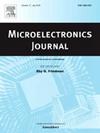A 4.5–37 GHz ultra-wideband amplifier with asymmetric T-coil matching network in 0.18-μm SiGe BiCMOS technology
IF 1.9
3区 工程技术
Q3 ENGINEERING, ELECTRICAL & ELECTRONIC
引用次数: 0
Abstract
This paper presents an ultra-wideband silicon-based amplifier designed to overcome the limitations of traditional transformer-based and distributed amplifier designs. The pro-posed amplifier is implemented in a 0.18 μm SiGe BiCMOS process and operates over a frequency range of 4.5–37 GHz. It features a single-stage differential topology using a common-emitter/common-base (CE-CB) configuration, with a series RC network for negative feedback. An asymmetric differential T-coil structure is employed for broadband input and output matching. Simulation results show return losses better than −10 dB across the full frequency range. The amplifier achieves a peak small-signal gain of 10.2 dB, with gain flatness of ±0.9 dB. It consumes less than 10 mW of DC power and delivers an OP1dB between 6 and 12.7 dBm. The core occupies only 0.14 mm2, making it suitable for compact and low-power broadband systems.
基于0.18 μm SiGe BiCMOS技术的非对称t圈匹配网络4.5-37 GHz超宽带放大器
本文提出了一种基于硅的超宽带放大器,克服了传统的基于变压器和分布式放大器设计的局限性。该放大器采用0.18 μm SiGe BiCMOS工艺,工作频率范围为4.5-37 GHz。它采用单级差分拓扑结构,采用共发射极/共基极(CE-CB)配置,采用串联RC网络进行负反馈。采用非对称差分t型线圈结构实现宽带输入输出匹配。仿真结果表明,在整个频率范围内,回波损耗优于- 10 dB。放大器的峰值小信号增益为10.2 dB,增益平坦度为±0.9 dB。它消耗的直流功率小于10mw,输出的OP1dB在6到12.7 dBm之间。核心仅占地0.14平方毫米,使其适用于紧凑和低功耗宽带系统。
本文章由计算机程序翻译,如有差异,请以英文原文为准。
求助全文
约1分钟内获得全文
求助全文
来源期刊

Microelectronics Journal
工程技术-工程:电子与电气
CiteScore
4.00
自引率
27.30%
发文量
222
审稿时长
43 days
期刊介绍:
Published since 1969, the Microelectronics Journal is an international forum for the dissemination of research and applications of microelectronic systems, circuits, and emerging technologies. Papers published in the Microelectronics Journal have undergone peer review to ensure originality, relevance, and timeliness. The journal thus provides a worldwide, regular, and comprehensive update on microelectronic circuits and systems.
The Microelectronics Journal invites papers describing significant research and applications in all of the areas listed below. Comprehensive review/survey papers covering recent developments will also be considered. The Microelectronics Journal covers circuits and systems. This topic includes but is not limited to: Analog, digital, mixed, and RF circuits and related design methodologies; Logic, architectural, and system level synthesis; Testing, design for testability, built-in self-test; Area, power, and thermal analysis and design; Mixed-domain simulation and design; Embedded systems; Non-von Neumann computing and related technologies and circuits; Design and test of high complexity systems integration; SoC, NoC, SIP, and NIP design and test; 3-D integration design and analysis; Emerging device technologies and circuits, such as FinFETs, SETs, spintronics, SFQ, MTJ, etc.
Application aspects such as signal and image processing including circuits for cryptography, sensors, and actuators including sensor networks, reliability and quality issues, and economic models are also welcome.
 求助内容:
求助内容: 应助结果提醒方式:
应助结果提醒方式:


